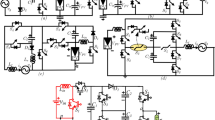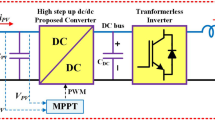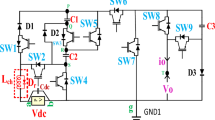Abstract
A low-frequency current ripple is introduced at the DC side of the single-phase inverter topology decreasing efficiency in the photovoltaic (PV), and battery systems and degrading the lifetime of an energy storage device. In this paper, a common-ground single-phase single-stage boost inverter for PV applications is presented. The introduced topology consists of three capacitors, one inductor, five switches, and four diodes. The introduced topology has the main features as the common ground between the DC input voltage source and AC output voltage, and voltage boost capability. Furthermore, the low-frequency input current ripple is significantly limited. Besides, the leakage current, which is one of the major problems in grid-connected PV applications, is limited in an introduced inverter. The operating principles, circuit analysis, Mathematical analysis, and PWM control strategy for the introduced inverter are discussed. The simulation results based on PSIM simulation are given at the end of the paper to confirm the feasibility, performance and viability of the introduced topology.
Access provided by Autonomous University of Puebla. Download conference paper PDF
Similar content being viewed by others
Keywords
1 Introduction
In the recent period, because of global surface temperature and energy crisis, using solar energy has been receiving more and more attention from many researchers. The distributed generation systems combined with solar energy have been rapidly researched. The single-phase grid-tied transformerless dc–ac inverters in PV applications are becoming more common worldwide [1]. However, a grid-connected system without a transformer generates a leakage current. This current flows through the parasitic capacitance to the ground, causing EMI problems, insecurity, and the low reliability of the grid-tied transformerless PV inverters [2, 3]. To solve this problem, some research works have been presented recently to limit the leakage current [4,5,6]. By clamping the common-mode voltage during the freewheeling period, the leakage current is reduced as discussed in [5, 6]. Recently, the transformerless PV inverters were introduced in [7,8,9] by using common ground configurations. In these topologies, the ground of the PV array and the utility grid is directly connected, so there is no leakage current. However, these topologies are a buck power conversion where the peak AC output voltage is smaller than the dc voltage.
In light of the above, a common-ground single-phase single-stage boost inverter is presented in this paper. The introduced topology has the main features as the common ground between DC input voltage source and AC output voltage, and voltage boost capability. In addition, the low-frequency input current ripple is significantly limited. The operating principles, circuit analysis, mathematical analysis, and PWM control strategy for the introduced inverter are given in Sect. 2. The simulation results based on PSIM simulation are given in Sect. 3.
2 Proposed Topology
The proposed common-ground single-phase single-stage boost inverter, which is indicated as in Fig. 1, consists of five switches, four diodes, a boost inductor, three capacitors. The same ground between dc input and ac output is an interesting feature of the introduced topology. From Fig. 1, we can see that the negative polarity of the dc input is directly connected to the ac output. It is merit, especially for PV applications. Figure 2 shows operating states of the proposed common-ground single-phase single-stage boost inverter. Figure 3 indicates the proposed PWM control method for the introduced topology. As shown in Fig. 3, a control waveform, Vcontrol and a fixed voltage, VST are compared with a carrier waveform, vtri to generate control signals for switches from S0 to S4.
In the boost state as shown in Fig. 2(a), four switches S0, S1, S3, and S4 are turned on while the switch S2 is turned off. As a result, the boost inductor is charged from the input dc source, Vg. The time interval in this state is D·T, where D and T represent the duty cycle and a switching period, respectively.
In the non-boost states as shown in Fig. 2(b), (c), and (d), the switch S0 is turned on. During the positive cycle as shown in Fig. 2(b), two switches S1, S4 are turned on while two switches S2, S3 are turned off. The output voltage, vab, in this case, equals VCC. During the negative cycle as shown in Fig. 2(c), two switches S2, S3 are turned on while two switches S1, S4 are turned off. The output voltage, vab, in this case, equals-VCC. Following the negative or positive cycle, two switches S2 and S4 are turned ON to generate a zero voltage. During the non-boost states, the boost inductor is discharged while the capacitor CB is discharged. The time interval in this state is (1–D)·T
The boost factor of the introduced topology is defined by
3 Simulation Results
To prove the operating principle of the proposed common-ground single-phase single-stage boost inverter, simulation results based on PSIM simulation are given. The simulation parameters for the introduced topology are given as in Table 1.
Figure 4 shows the simulation waveforms of the proposed common-ground single phase single stage boost inverter when the input voltage is 96 V. As shown in Fig. 4(a) and Fig. 4(b), we can see that the peak ac output voltage of the introduced topology is 310 V. The peak value of the load current is 6.2 A. As shown in Fig. 4(a), the low-frequency current ripple is reduced significantly. From Fig. 4(d), the peak-to-peak inductor ripple current is 4 A. From Fig. 4(c) and Fig. 4(d), the stress voltage across four switches S1, S2, S3, and S4 are the same as dc bus voltage while the stress voltage across switch S0 is equal to half of dc bus voltage.
Simulation results of the introduced inverter when input dc voltage is 96 V. From top to bottom, (a) input voltage, input current, output voltage of the inverter, current load; (b) FFT of output voltage of the inverter, current load; (c)-(d) drain-source voltage of switches and zoom version of input current.
4 Conclusion
This paper proposes the common-ground single-phase single-stage boost inverter for PV applications. The circuit analysis, and mathematical analysis, operating principles of the introduced inverter are provided. A simple PWM control method is introduced to modulate the proposed inverter. The introduced topology has the main features as the common ground between DC input voltage source and AC output voltage, and the voltage boost capability. Furthermore, the low-frequency input current ripple is significantly limited. Besides, the leakage current, which is one of the major problems in grid-connected PV applications, is limited in the introduced inverter. Since the proposed common-ground single phase single stage boost inverter has a high reliability, there is no leakage current and voltage boost capability, it is suitable for PV applications. The simulation results based on PSIM simulation are given at the end of the paper to confirm the feasibility, performance and viability of the proposed topology.
References
Kjaer, S.B., et al.: A review of single-phase grid-connected inverters for photovoltaic modules. IEEE Trans. Ind. Appl. 41(5), 1292–1306 (2005)
Ribeiro, H., Borges, B., Pinto, A.: Single-stage DC–AC converter for photovoltaic systems. In: Proceedings IEEE Energy Conversion Congress and Exposition, Atlanta, USA, pp. 604–610. IEEE (2010)
Gonzales, R., Lopez, J., Sanchis, P., Marroyo, L.: Transformerless inverter for single-phase photovoltaic systems. IEEE Trans. Power Electron. 22(2), 693–697 (2007)
Stalter, O., Wellnitz, P., Burger, B.: Flying capacitor topology for grounding of single-phase transformerless three-level photovoltaic inverters. In: 16th European Conference on Power Electronics and Applications, Lappeenranta, Finland, pp. 1–9, IEEE (2014)
Ji, B., Wang, J., Zhao, J.: High-efficiency single-phase transformerless PV H6 inverter with hybrid modulation method. IEEE Trans. Ind. Electron. 60(5), 2104–2115 (2013)
Xiao, H.F., Zhang, L., Li, Y.: An improved zero-current-switching single-phase transformerless PV H6 inverter with switching loss-free. IEEE Trans. Ind. Electron. 64(10), 7896–7905 (2017)
Vazquez, N., et al.: Integrating two stages as a common-mode transformerless photovoltaic converter. IEEE Trans. Ind. Electron. 64(9), 7498–7507 (2017)
Siwakoti, Y.P., Blaabjerg, F.: A novel flying capacitor transformerless inverter for single-phase grid-connected solar photovoltaic system. In: IEEE 7th International Symposium on Power Electronics for Distributed Generation Systems (PEDG), Vancouver, Canada, pp. 1–6. IEEE (2016)
Siwakoti, Y.P., Blaabjerg, F.: Common-ground-type transformerless inverters for single-phase solar photovoltaic systems. IEEE Trans. Ind. Electron. 65(3), 2100–2111 (2018)
Acknowledgment
This research was supported by Research Foundation funded by Thai Nguyen University of Technology.
Author information
Authors and Affiliations
Corresponding author
Editor information
Editors and Affiliations
Rights and permissions
Copyright information
© 2021 The Author(s), under exclusive license to Springer Nature Switzerland AG
About this paper
Cite this paper
Ngo, MD., Nong, QV., Ngo, TN., Nguyen, HQ., Tran, TT., Ahn, SJ. (2021). A Common-Ground Single-Phase Boost Inverter with Suppressed Double-Frequency Ripple for Photovoltaic Applications. In: Sattler, KU., Nguyen, D.C., Vu, N.P., Long, B.T., Puta, H. (eds) Advances in Engineering Research and Application. ICERA 2020. Lecture Notes in Networks and Systems, vol 178. Springer, Cham. https://doi.org/10.1007/978-3-030-64719-3_3
Download citation
DOI: https://doi.org/10.1007/978-3-030-64719-3_3
Published:
Publisher Name: Springer, Cham
Print ISBN: 978-3-030-64718-6
Online ISBN: 978-3-030-64719-3
eBook Packages: EngineeringEngineering (R0)








